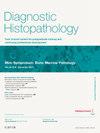Hemophagocytic lymphohistiocytosis and other histiocytic disorders of the bone marrow in children
引用次数: 0
Abstract
The primary functions of bone marrow histiocytes are to remove cellular debris (phagocytosis) and to store and metabolize iron. Increased bone marrow histiocytes can be seen in both non-specific reactive settings and in histiocytic disorders. One such entity, hemophagocytic lymphohistiocytosis (HLH), is a hyperinflammatory syndrome resulting from excessive and uncontrolled immune activation. Bone marrow hemophagocytosis, the ingestion/engulfment of intact nucleated cells by marrow histiocytes, is one of the diagnostic criteria of HLH, along with fever, splenomegaly, cytopenias, hypofibrinogenemia, hypertriglyceridemia, and other evidence of immune/T-cell activation. As such, bone marrow evaluation is an important component of the HLH work-up, performed to identify hemophagocytic histiocytes and to evaluate for potential triggers of immune activation, such as a hematologic malignancy. Bone marrow evaluation can also be helpful in the diagnosis of other histiocytic proliferations, such as metabolic storage disorders including Gaucher disease and Niemann-Pick disease. Increased bone marrow histiocytes may also represent involvement by histiocytic/dendritic cell neoplasms, such as Langerhans cell histiocytosis, juvenile xanthogranuloma, or ALK-positive histiocytosis. This review will examine the bone marrow findings, diagnostic work-up, and underlying causes of HLH, as well as discuss other histiocytic bone marrow proliferations that can affect the pediatric population.
儿童骨髓的噬血细胞、淋巴组织细胞病和其他组织细胞疾病
骨髓组织细胞的主要功能是清除细胞碎片(吞噬)和储存和代谢铁。骨髓组织细胞增多可在非特异性反应设置和组织细胞疾病中看到。噬血细胞性淋巴组织细胞增多症(HLH)是一种由过度和不受控制的免疫激活引起的高炎症综合征。骨髓噬血细胞症,即骨髓组织细胞吞食/吞噬完整的有核细胞,是HLH的诊断标准之一,此外还有发热、脾肿大、细胞减少、低纤维蛋白原血症、高甘油三酯血症和其他免疫/ t细胞活化的证据。因此,骨髓评估是HLH检查的重要组成部分,用于识别噬血细胞组织细胞和评估免疫激活的潜在触发因素,如血液恶性肿瘤。骨髓评估也有助于其他组织细胞增生的诊断,如代谢储存障碍,包括戈谢病和尼曼-匹克病。骨髓组织细胞增多也可能代表组织细胞/树突状细胞肿瘤的参与,如朗格汉斯细胞组织细胞增多症、幼年黄色肉芽肿或alk阳性组织细胞增多症。这篇综述将检查骨髓的发现、诊断检查和HLH的潜在原因,以及讨论其他可能影响儿科人群的组织细胞骨髓增生。
本文章由计算机程序翻译,如有差异,请以英文原文为准。
求助全文
约1分钟内获得全文
求助全文
来源期刊

Diagnostic Histopathology
Medicine-Pathology and Forensic Medicine
CiteScore
1.30
自引率
0.00%
发文量
64
期刊介绍:
This monthly review journal aims to provide the practising diagnostic pathologist and trainee pathologist with up-to-date reviews on histopathology and cytology and related technical advances. Each issue contains invited articles on a variety of topics from experts in the field and includes a mini-symposium exploring one subject in greater depth. Articles consist of system-based, disease-based reviews and advances in technology. They update the readers on day-to-day diagnostic work and keep them informed of important new developments. An additional feature is the short section devoted to hypotheses; these have been refereed. There is also a correspondence section.
 求助内容:
求助内容: 应助结果提醒方式:
应助结果提醒方式:


